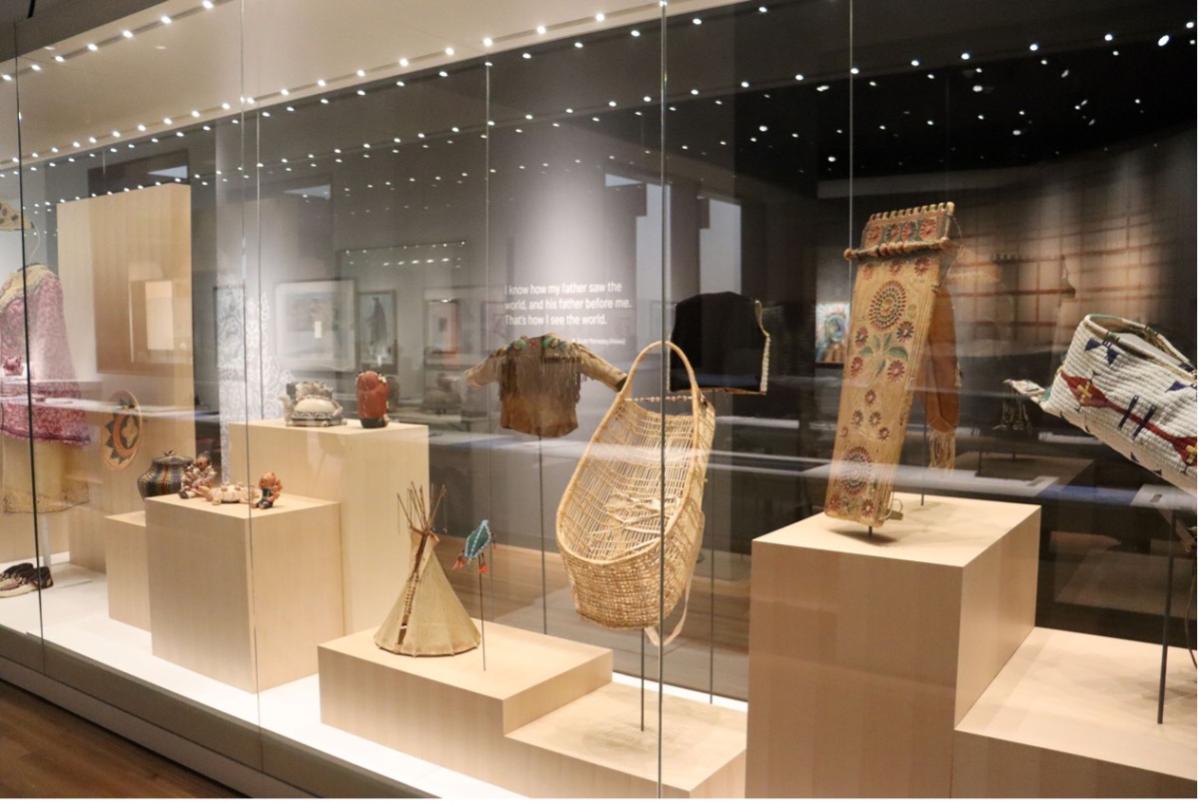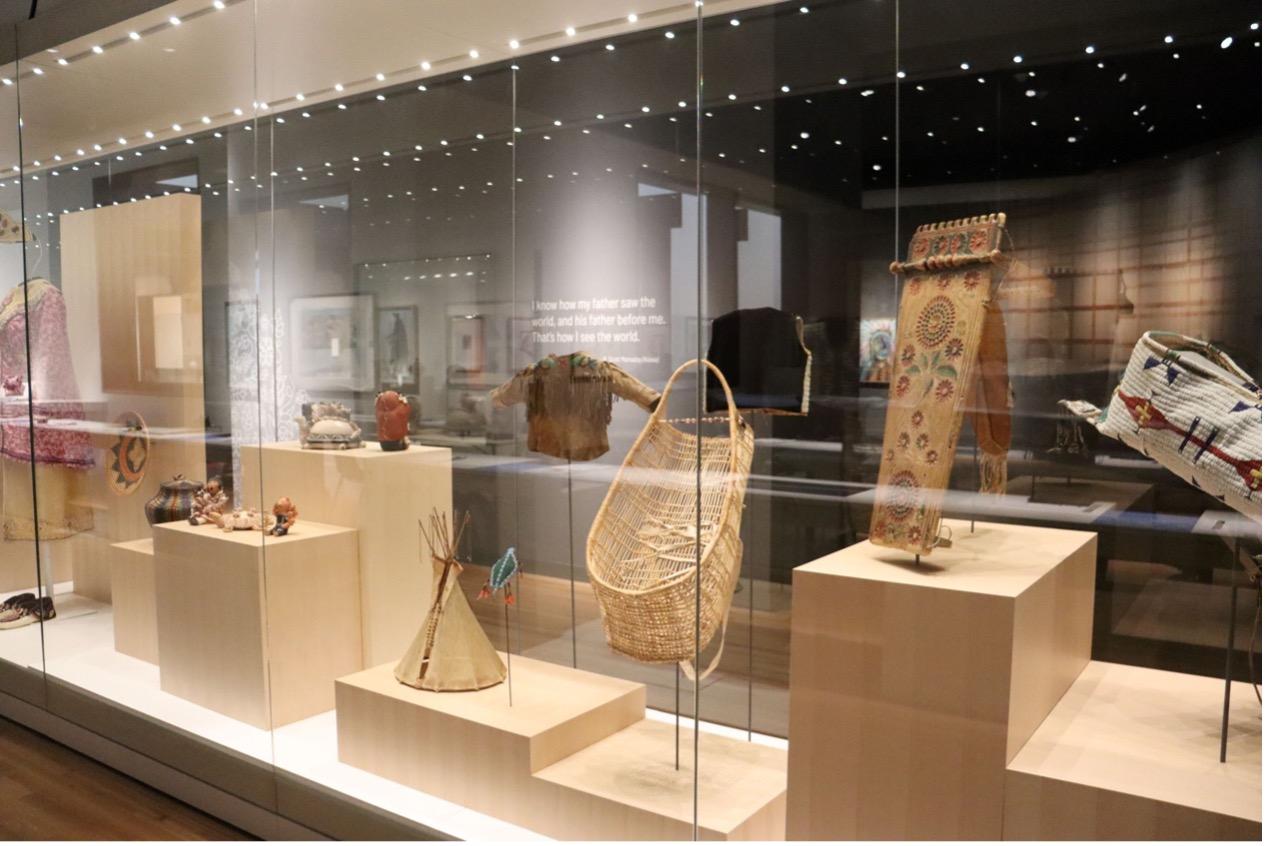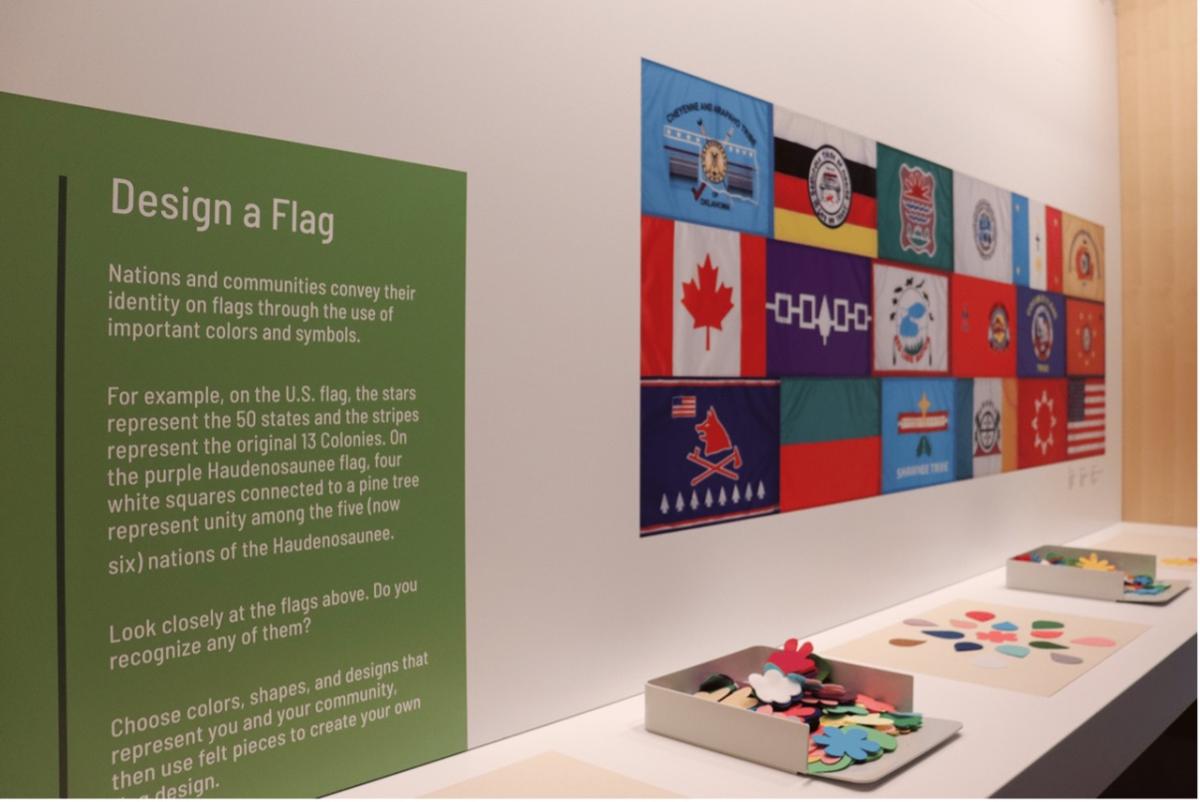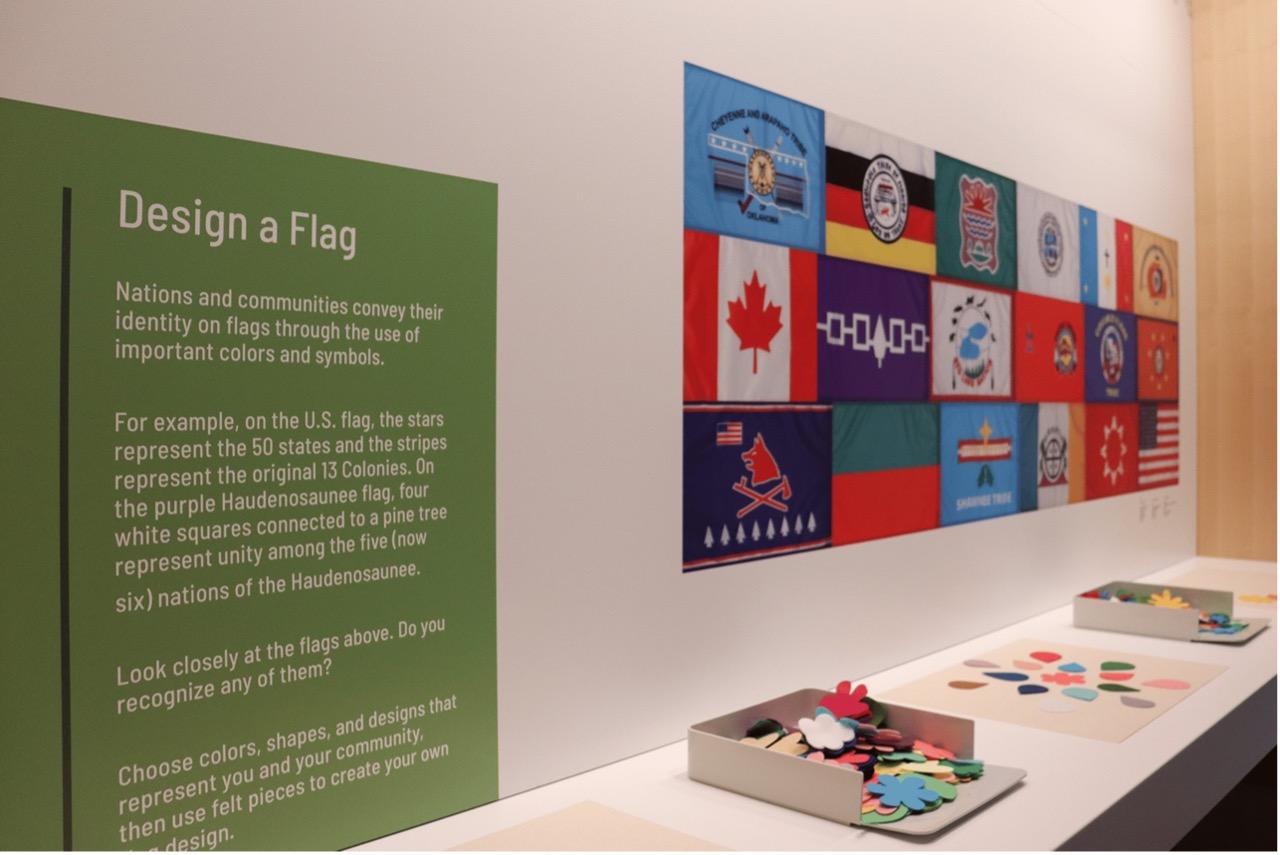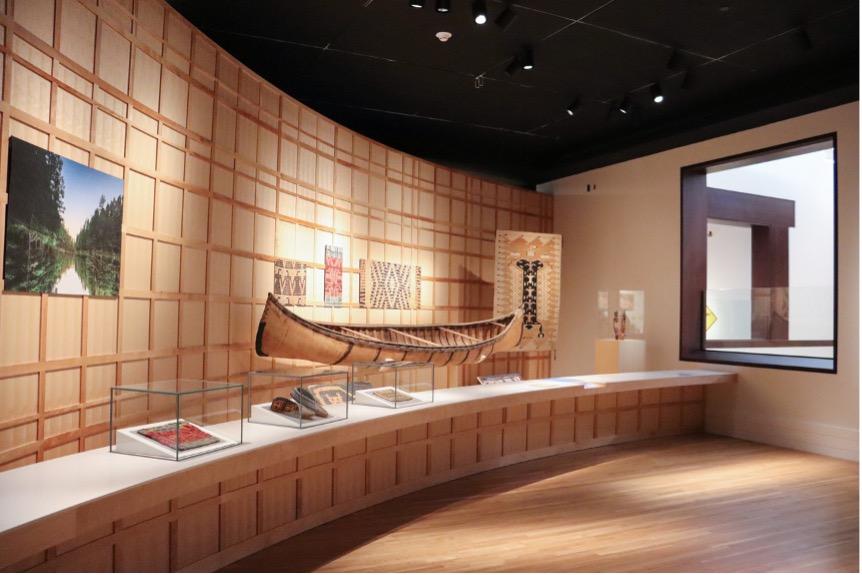A New Perspective on Displaying Native American Art: How the Eiteljorg Museum Rethought its Native American Galleries
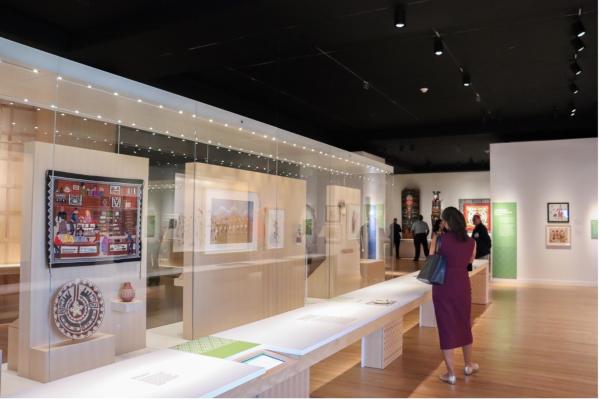
Visitors admire the renovated Eiteljorg Native American galleries, including textiles and art displayed in new glass cases.
Image courtesy of the Eiteljorg Museum.

Visitors admire the renovated Eiteljorg Native American galleries, including textiles and art displayed in new glass cases.
Image courtesy of the Eiteljorg Museum.
Since its founding in 1989, the Eiteljorg Museum has garnered recognition as one of the relatively few museums east of the Mississippi dedicated to collecting and interpreting Native American and Western art. As the Eiteljorg’s thirtieth anniversary approached in 2019, staff focus turned to reenvisioning the approach to their core Native American galleries, which had not significantly evolved in those thirty years. Because the museum sits upon the ancestral land of many tribes, including the Myaamiaki (Miami), Bodéwadmi (Potawatomi), Lenape (Delaware), Saawanwa (Shawnee), Kiikaapoi (Kickapoo), and Peouaroua (Peoria) peoples, staff was also determined to strengthen the Eiteljorg’s relationships to local tribal communities. With the help of an Infrastructure and Capacity Building (ICB) grant from the NEH’s Office of Challenge Programs and in collaboration with local tribal communities, the Eiteljorg opened the doors to reenvisioned and renovated Native American galleries in June 2022.
The Eiteljorg’s vice president, chief curatorial officer, and ICB grant project director, Elisa Phelps, sat down with the Office of Challenge Programs to discuss the new galleries. Phelps credits former Native American art curator Scott Shoemaker (Miami) and current Native American art curator Dorene Red Cloud (Oglala Sioux) as the originators of the reimagined galleries. According to Phelps, “they worked on big ideas and made a general interpretive plan for how they wanted to approach [renovating the galleries]. We were heading down that path where it was more linear—things like nationhood, family, unity, ceremony, the natural world—things that you’ve seen in other exhibits. In their discussions, they felt like this approach was still taking an outside, anthropological perspective towards the subject matter.” The Eiteljorg had previously divided the galleries into cultural areas, such as people of the plains and cultures of the Southwest. Being Native themselves, Shoemaker and Red Cloud felt strongly that the new design should center on shared Indigenous perspectives.
“They began discussing themes that are common throughout Indigenous life and culture. They came up with three big ideas and the key points of exploration: relation, continuation, and innovation. Those incorporated family, community, sovereignty, religion, ritual, and other themes from the previous iteration.” This creative process culminated in the ideas that Native people are still here, Native people are diverse, and Native art is on a continuum. “We later added a fourth idea which is Native people are the authorities on their own experiences. It’s not about what I [a curator] think the art is about or have learned the art is about, it’s from Indigenous perspectives.”
With the vision to completely redesign the museum’s second-floor galleries, the Eiteljorg launched a $55 million capital campaign supported by a $150,000 matching ICB grant from the NEH. Donations totaling $450,000 allowed the Eiteljorg to meet the 1:3 funding ratio required for the project. The NEH award funded new casework designed to display objects in 360 degrees, which would allow visitors of different heights to view the displays and help collections staff to rotate the objects. Phelps says that the cases were the largest expense for the galleries but a necessary change. Because the old cases were difficult to access, the old casework kept the exhibit in a state of stagnation. Phelps recalls that “while some of the pieces rotated in and out, the rest of it never changed…one of the challenges of the old exhibit is that since things were clunky to get into—some had giant pieces of glass that are hard to remove with only one person—things did not rotate to the extent that they should.” The new cases, however, are “wonderful,” as Phelps proclaims. “They’re beautiful, light, open, and accessible. While keeping the pieces secure, they’re designed for collections staff to be able to rotate things.” Most of them have a 360-degree view of the objects, which was not possible before. “Especially if you’re looking at a piece of clothing or textile, seeing the other side is often just as interesting as the primary side. I think it’s the thing that folks have talked about the most: how beautiful the exhibit is, and how they can really see and appreciate the art in a different way than before because the casework showcases the art and recedes in the background.”
The new galleries are guided by three core tenets: Native people are still here, Native people are diverse, and Native art and practice are connected throughout time. The galleries reflect these tenets through the main themes of relation, continuation, and innovation. Relation describes the connection between Indigenous peoples of the Great Lakes region and beyond to spirits, animals, plants, and one another through community, family, and nation. Continuation echoes the statement that Native people are still here and have continued to exist despite efforts to assimilate them and violence directed towards them. In the galleries, visitors can learn about sovereign nations and design a flag reflecting their own family and community or contribute to a community weaving project as they learn about Indigenous resiliency in the face of forced removal. Lastly, the theme of innovation celebrates the artistic achievements of Native artists through traditional and contemporary media. The concluding area of the galleries asks visitors to discuss “What is art?” while filmed interviews of Native artists explore what it means to be Native.
The Eiteljorg collaborated with their Native American advisory council during the project development process. The Council advises the museum’s board and staff in areas including repatriation, exhibitions, education, and collections. Members of the council represent cultures across the country, including former Native American art curator Scott Shoemaker. “One of the positive byproducts of COVID-19 was that previously we had met only a couple of times per year” due to the difficulty and cost of travel, Phelps says. “With Zoom, we began meeting monthly. That was awesome. A completely unexpected side benefit of being forced to do things virtually is that we were able to really stay engaged with the advisory council. In terms of exploring the themes, we have this continuity and deeper engagement with Native voices. So COVID has been a terrible, tragic experience for everyone, but in that tiny way, it was a positive for us. And we will continue to meet virtually at least quarterly to keep the engagement going.”
Phelps defines the council, which has been involved since the museum’s founding, as “our sounding board and true advisors.” As the galleries developed, Eiteljorg staffers shared information with them and sparked discussion. Phelps reveals that “even the title, “Expressions of Life: Native Art in North America,” came from the Advisory Council. “It was important to us for folks to be united and excited about how verbally it was being packaged for the public.” She also acknowledges how several advisors contributed stories and information about their tribal background or other aspects of Indigenous life that are part of the media exhibits.
These efforts have also deepened relationships with tribal communities and culturebearers. Phelps recognizes Shoemaker, an enrolled member of the Miami Tribe of Oklahoma, for initiating connections with tribes, and Red Cloud, for sustaining and expanding them. Phelps expresses how the Eiteljorg’s new galleries paved the way for a closer relationship with Indigenous communities, particularly the Delaware Tribe. “[The Delaware] participated in the exhibit by loaning us an important item that belongs to them and sharing information about that item and its significance for the media program for the public to access.”
Phelps notes that the Eiteljorg is looking to sustain these relationships by hiring a curator of Great Lakes Native cultures and community engagement. “The goal,” she explains, “is for this individual to work with the art collection and the beautiful objects we have, but also work with the tribes to share the resources we have with them and to bring their knowledge and art into the museum.” The galleries also include a small rotating exhibit space currently featuring new acquisitions tied to current events, including the missing and murdered Indigenous women crisis and the COVID-19 pandemic’s impact on tribal communities. “We have an opportunity to work with tribal representatives or tribal museums and community centers to showcase what they would like to share with the public,” explains Phelps.
While the pandemic may have encouraged more frequent virtual meetings of the advisory council, it also had negative impacts on the museum’s plans. The pandemic curtailed the Eiteljorg’s plans to facilitate in-person consultations with different tribal representatives. Groups of elders and artists from the nearby Pokagon Band of Potawatomi visited the museum before the shutdowns in 2020, while other visits to and from other tribes had to be rescheduled or canceled entirely. Reduced staff capacity also affected the Eiteljorg’s project; however, staff worked remotely and collected digital interviews with artists and culturebearers, now featured throughout the galleries. Through these partnerships, the Eiteljorg hopes to serve as a resource connecting tribal communities—including tribal museums and cultural centers—and expanding access to collections through loans, artist residencies, and professional development opportunities.
The pandemic also impacted the design process for the galleries. After selecting the Ottawa-based Origin Studios, Phelps recalls that “we did not meet face-to-face with the team until the galleries’ opening. But it worked. Everything we did in terms of gallery design was done virtually.” Phelps is optimistic about their virtual collaboration despite the challenges of the pandemic. “If you’d asked me if that would work at the beginning of the pandemic, I might have been a little dubious, but it did. And it was all the nicer when we were able to meet face-to-face. But that was a big impact. I’ve never worked on a project where you haven’t met face-to-face with the design team.” Despite these challenges, the Eiteljorg reopened the doors to “Expressions of Life: Native Art in North America” in June.
Phelps came aboard the project after the grant application process but shared advice for applicants of ICB grants: have a sense of donor prospects to provide matching funds: “In our development department, we had a list of who we thought might be good prospects, so we weren’t scrambling to get the matching money. We had a plan and strategy in place to bring people in throughout the application and funding process.”
Looking ahead, Phelps explains, “Whether it’s a Challenge grant or another type of NEH program, I’m sure we will be submitting more proposals in the future.” The Eiteljorg is still settling into the new galleries and plans to focus its efforts on school outreach, with robust resources built by the education department on their website for educators to access. The galleries themselves are still evolving, and Phelps hopes changing content will draw in more visitors. “We haven’t been through the first round of rotations yet, but that’s coming up,” she said. “We hope visitors will become repeat visitors and there will be something different for them to see when they come through.”
In the galleries, Phelps can see visitors enjoying the new space: “It’s just exciting to walk through the gallery and listen as folks talk about it with their party. It’s always fun and exciting because people seem to be not only enjoying the art but learning from it and taking away something they didn’t know before. If nothing else, they can see that Native people are still here.”
The Eiteljorg Museum was awarded an Infrastructure and Capacity Building Challenge grant in 2019. “Expressions of Life: Native Art in North America” is now open at the Eiteljorg Museum.
For more information on the Infrastructure and Capacity Building Challenge grant, please visit our program page. Contact @email with questions.
